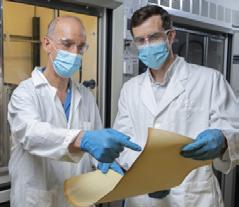
2 minute read
Membrane Technology Could Cut Emissions, Energy Use in Oil Refining
from Georgia Tech's ChBE 2020 Magazine
by School of Chemical & Biomolecular Engineering at Georgia Tech
New membrane technology developed by a team of researchers from Georgia Tech, Imperial College London, and ExxonMobil could help reduce carbon emissions and energy intensity associated with refining crude oil. Laboratory testing suggests that this polymer membrane technology could replace some conventional heatbased distillation processes in the future.
Fractionation of crude oil mixtures using heat-based distillation is a large-scale, energyintensive process that accounts for nearly 1% of the world’s energy use: 1,100 terawatt-hours per year (TWh/yr), which is equivalent to the total energy consumed by the state of New York in a year.
Advertisement
By substituting the lowenergy membranes for certain steps in the distillation process,
In a remote village, an aid worker pricks a sickly toddler’s fingertip, and like most of the other children’s blood samples, this one turns a test strip yellow. That’s how an experimental malnutrition test made with bacterial innards could work one day in the field to expose widespread zinc deficiencies that kill thousands every year.
These innards include plasmids, which are loops of DNA. They are not the same DNA strands behind reproduction and cell construction, but function instead like nano-organs with genetic programs that normally guide bacterial cell processes. In a study led by Georgia Tech, researchers engineered plasthe new technology might one day allow implementation of a hybrid refining system that could help reduce carbon emissions and energy consumption significantly compared to traditional refining processes.
Published in the journal Science, the paper is believed to be the first report of a synthetic membrane specifically designed for the separation of crude oil and crude-oil fractions. Additional research and development will be needed to advance this technology to industrial scale.
The research team created an innovation pipeline that extends from basic research all the way to technology that can be tested in real-world conditions. mids to direct other parts extracted from bacteria to make the blood test work.
The new technology showed high potential as a basis for an inexpensive, easy malnutrition test that could be expanded to include many vital nutrients and other health indicators.
“We brought together basic science and chemistry, applied membrane fabrication fundamentals, and engineering analysis of how membranes work.” - ChBE Associate Professor Ryan Lively
“We were able to go from milligram-scale powders all the way to prototype membrane modules in commercial form factors that were challenged with real crude oil – it was fantastic to see this innovation pipeline in action."










